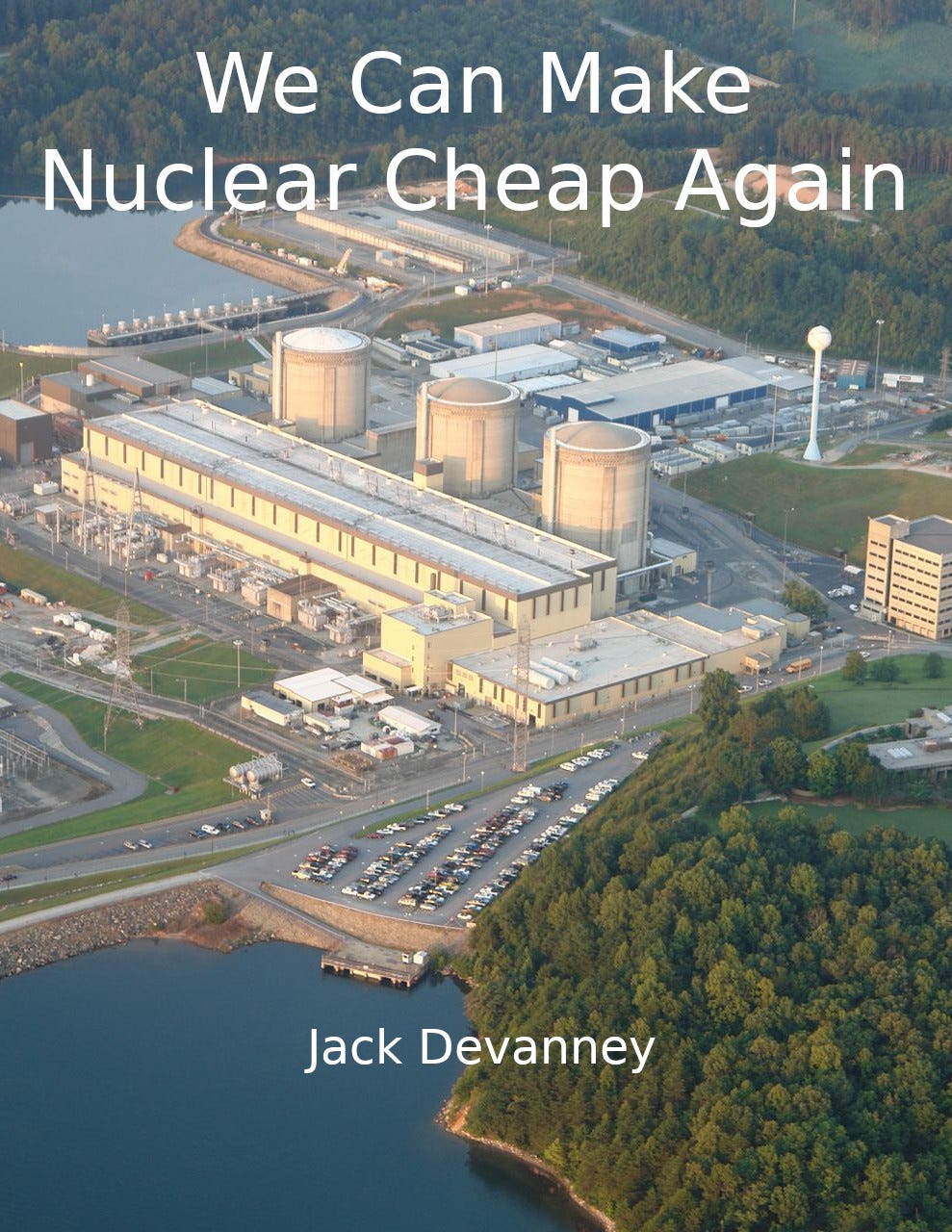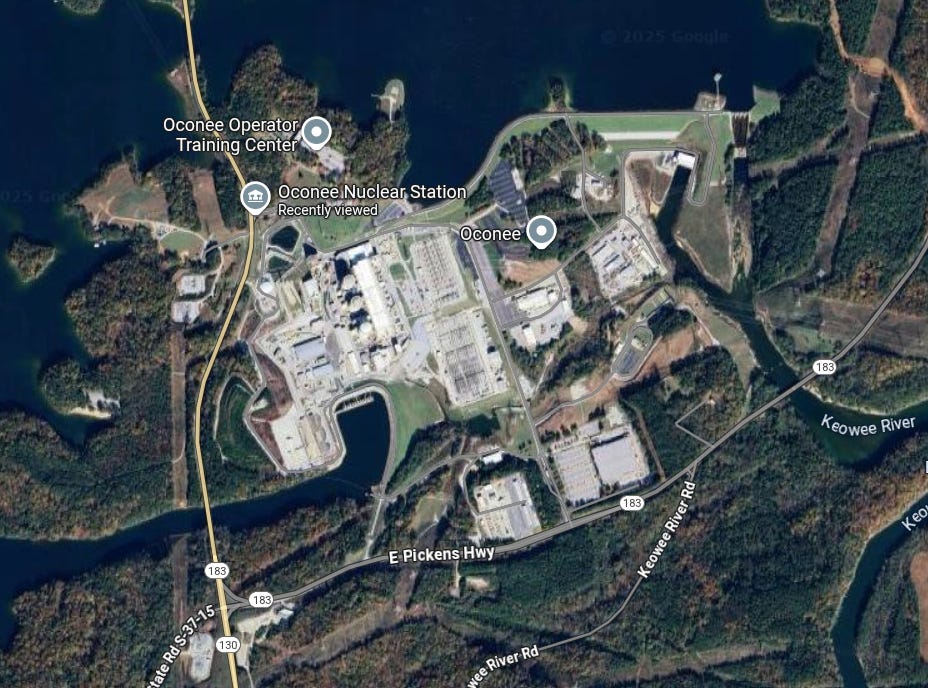Judging a Book by its Cover, Part 2
Figure 1. The Oconee Plant. Suitable for coffee tables everywhere.
In a desperate attempt to hype the nearly non-existent sales of We Can Make Nuclear Cheap Again, the book has been clad in a snazzy new cover, Figure 1. The new backmatter reads.
The front cover is a shot of the 2.5 gigawatt Oconee plant in South Carolina. These three reactors were built for 356 million dollars between 1967 and 1974. That is about $1100 per kilowatt in 2024 dollars.1 Oconee can produce reliable, on-demand, zero pollution, very low CO2 electricity at less than 3 cents/kWh in today's money.
Between 1970 and 2025, technological progress should have reduced the real cost of nuclear power. Instead the current cost of nuclear plants in Europe and North America is more than $15,000/kW, more than 13 times the cost of Oconee. Thanks to its insane energy density, nuclear power should consume far less of the planet's precious resources than any other source of electricity while producing nearly no pollution and very little CO2. Instead nuclear is a prohibitively expensive flop.
This little book explains why this auto-genocidal tragedy happened, and what we can do about it. Nuclear's problems are entirely man-made. What is man-made can be man-unmade. If we adopt the regulatory reforms that this book lays out, the providers of nuclear power will be forced to compete with each other and new entrants on a level playing field, in which case the inherent cheapness of fission power combined with technological advances will push the cost of nuclear electricity back down to its should-cost.
Nuclear would undercut fossil fuel almost every where. Fossil would be relegated to a bit of peaking and backup for unplanned outages. Intermittents would be limited to a few niche markets. This would all be automatic. No need for subsidies or mandates. The poor would be immensely richer. Electrification of transportation and industry would explode. Desal would take off. Synthetic fuels could become viable. Skies would be clean. All this electricity would require little land and produce almost no CO2. The planet would be cooler. Could there be a more joyful message?
The Nuclear Reorganization Act draft has been included by reference to its GKG web site copy, making updates easier. The UCert chapter has been rewritten to emphasize the fact that UCert requires Congress to directly regulate nuclear power rather than delegate this role to an autocratic bureaucracy. The decrease in page count dropped the price under 30 bucks. Buy it, read it, and then send the copy to your Congressman.
We interrupt this commercial to point out just how impressive the Oconee plant is. It's small. It's takes up less than 500 acres (200 hectares) of land. It's big. It's the fourth largest power plant in the US in terms of actual electricity supplied. It stays up. This 52 year old plant's capacity factor averaged over the last 5 years was a jaw dropping 98.2%. That's 22 million tons of CO2 per year that did not get emitted. It keeps going. All three reactors have received operating licence extensions which will take them into the 2050's.
Figure 2. Satellite View of Oconee. 2.7 GW on less than 2 km2 of land.
But the most interesting feature of Oconee is its back up power. Duke sited the plant right next to the dam across the Keowee River which formed the lake which serves as the plant's cooling pond. Lake Keowee has turned a depressed part of western South Carolina into a second home and tourist magnet. The dam is just to the right of the plant in Figure 2.
Here's the clever part. Oconee has no backup diesels. Duke fitted the dam with a 157 MW hydro plant. The hydro plant has a direct cable to Oconee switchyard, actually two, one above ground and one under. If Oconee has a station black out, a couple of circuit breakers will close, and instant, nearly forever emergency power. I'm a big fan of always on backup. Always on means always maintained which means always ready to go.2 And for the purists, no CO2 from testing the diesels.
Of course, by far the coolest feature of Oconee is how cheap it was. All nuclear plants could and should be this cheap.
Lovering et al put the overnight capital cost (stripped of construction period interest expense) at $875/kW, which would indicate an interest expense of about $225/kW in 2024 dollars.
I wonder if Duke thought about going one step further, and routing a tiny portion of the dam's flow to the nuke's condensers, eliminating those big pumps, and ensuring condenser cooling, even if everything else fails. You could even imagine a gravity driven, emergency line to the primary loop.




Hydro and nuke are a marriage made in heaven. Not surprisingly, most of the success stories in nuclear were actually nuclear+hydro grids. The nuke does the baseload, the hydro can throttle easily for peaking/load following, without wastage. Throttling nukes requires control rods so that wastes fuel, the hydro plant just raises the reservoir water level, so energy can be stored for later.
One idea I am particularly fond of is to use the hydro reservoir as a cooling lake. No ugly cooling towers, and better thermal efficiency for the nuke plant. Plus the recreationists will appreciate a few degrees warmer water.
Another idea that extends from this naturally is to use the reservoir also as backup cooling, gravity driven feed to the steam generators (PWR) or isolation condenser tanks (BWR). just a simple hand valve and no more Fukushimas. Years of shutdown cooling supply all gravity fed at a quarter-turn twist of a ball valve.
Coupla problems though. Hydro dams tend to be in difficult to reach areas. Ideal sites have barge access, ideally from sea. Hydro dams tend to be the opposite unless the entire hydro river is navigable with decent under keel clearance for barges. In my case it is even worse, we have a flat country - no hydro dams to begin with.
In terms of covers. Can nuke developers please refrain from using Soviet gray and bare concrete "colors". What's a nice fresh paintjob in the big scheme of things? Yucca Mountain still has ugly rusted pipes sticking out of the tunnel.
Great article and footnotes. I worked for NZBC, New Zealand's equivalent of the BBC in the UK for six years as my first job. Our standard operating procedure was to run backup generators on full load for at least two hours every month. Long experience had taught them that you don't just make sure they run now and then. The last site I was stationed at had 1MW of backup power, being the largest transmitter site in the country. (A WW2 submarine diesel power plant coupled to a suitable alternator). During the winter months Porirua City substation control would call us up about 5-5:30 in the afternoon and ask us to go to backup power for a couple of hours to help them ride out the "Come home and switch the lights and the stove on" peak usage.